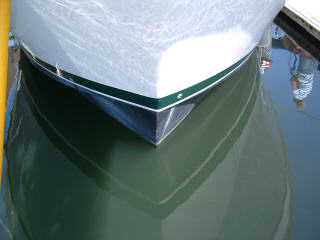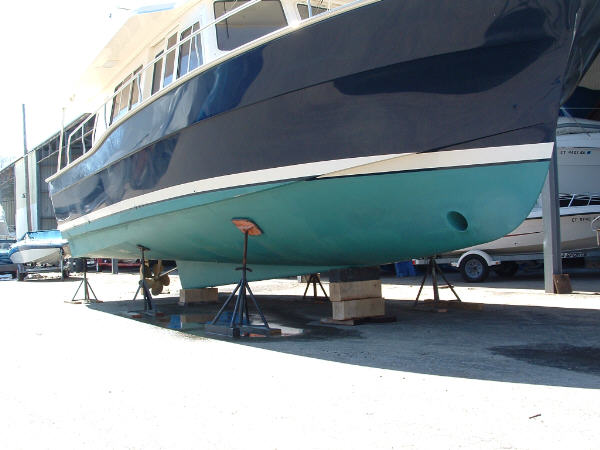The 400 Trawler and Speed
Mainship builds a few different models in their "Trawler" series. Mainship uses the word "Trawler" as a model name, and not necessarily a type of boat. Their "Trawler" line is a modern variation of what you might expect a traditional trawler to be. "Trawler" brings to mind attributes like, displacement hull, raised pilot house, single engine, long range, seaworthiness, passage maker. Trawler designs range from twin engine Grand Banks classics to single engine passage makers from Kadey Krogen & Nordhaven. This is in contrast to the boats called "trawlers" by Mainship. The modern Mainship "performance trawlers" are a compromise between these traditional trawlers and typical faster planing hull. Being neither true displacement hulls nor planing hulls, but a compromise called a "semidisplacement hull". Semidisplacement, can describe a wide variety of hulls on the water today that can range from a soft chine, fine entry, lobster boat type (traditional down easter) to various trawler and nonplaning type hulls. Even within the Mainship trawler series, the hulls vary greatly in their design and performance. Below are examples of two different designs in that Mainship Trawler series.
 |
 |
|
The Mainship 430, a hull with planing characteristics for contrast, has a more blunt entry with convex surfaces that bend closer to horizontal to provide lift for high speed operation. The hull flattens quicker and is more of a modified deep vee. |
The fine entry of the 400 Trawler hull is shown above. This type of design is used by the down east lobster boat builders to provide a comfortable ride, and to allow the boat to maintain her way, slicing though the sea in rough weather. She's built to glide through the water with minimal power, resulting in good efficiency at typical slow trawler speeds (hull speed about 8 kts.) The concave flare of the 400 with fine entry parts the water and rolls it away, using minimal energy to do so. |
Most of the Mainship models, from the 34 Trawler, through the 400 are available as twin or single screw versions. The 430, is available as a twin screw only. (The Pilot series, a down east style, is a completely different concept, and is not considered a trawler.) The focus of this article is my experience with the single screw Mainship 400 Trawler.
If planing speed is your goal, do not consider a single screw 400 trawler. You will not be happy. It is an absolutely wonderful boat, but it does not go fast. Just take a look at the picture above. It has a very round bilge and a good sized keel. This boat design leans more towards traditional trawler lines in the forward two/thirds of the boat. But unlike a canoe stern displacement boat, the stern is square and almost flat bottomed. This provides some planing properties, but this is not a planing hull by any means.
This is not to say that you are stuck with displacement speeds of traditional trawlers, but if you try to make it go fast, you will lose the wonderful efficiency of this hull in fuel consumption. At WOT, using the trim tabs, the square stern with flat bottom section, will let you power through the water at speeds up to about 13.5 knots with the single 370. Being a semi-planing (semi-displacement) type hull, she will not rise onto plane like a planing hull. When a true planing hull climbs over the bow wave and lifts onto plane, approximately one third to one half of the forward part of the boat will rise above the surface of the water and reduce wetted surface substantially. This reduces drag and alows the boat to accelerate further. The fine entry and round bilge found on this design, do not produce that kind of lift, but let the hull slice through the water.The wide flat stern section will provide some lift to keep the stern from squatting to much. The bow will rise some what when pushed hard, but that is more a function of propulsion thrust forces than any lift being generated by the hull.
So where does the 400 shine? She glides thru the water effortlessly at 8 knots sipping about 2 3/4 gallons per hour at 1900 rpm. She has a fine entry with a flare that parts the water very cleanly, rolls it up, and pushes it aside. She will create a short, steep wake in the process. Watch your wake above 7 knots, to about 10 knots. It is easy to swamp a small boat or knock someone off a floating dock. Beyond 10 knots, the wake begins to flatten out. In the 7 - 8 knot range, she will ride level and you can forget using the trim tabs as they will slow the boat in this speed range. Now if you are a sailing convert like I, you will love the quiteness of this boat at this speed. On the flybridge, you will enjoy steady ride with living room conversation levels. Now if the sea makes up, and you have a 3-4 foot chop on the nose, your ride will improve if you power up to about 2600 rpm. You will give up considerable fuel economy but the ride will be worth it. She will power through the waves smoothly at a good angle of attack. It does help to use trimtabs at and above 2600 rpm, to keep the nose down and cutting though the water.
Now if we need to get somehere a little quicker for some reason, you can cruise the boat continuously at 3100 RPM according to the Yanmar tables.Using the trim tabs, you can wring out about 12 knots, but your range will be reduced considerably (see the specs page for fuel economy and range.) When fast cruising above 10 knots, you can gain about .5-.6 knots with out any rpm or power changes by using the trim tabs to bring the bow back to down to normal attitude. Stella Blue will do 13.5 knots at WOT which is 3425 RPM. The continous duty HP rating of the Yanmar 6LYA-STP (370 HP) is 290 HP at 3100 RPM, so you cannot run the boat at WOT for extended periods.
Some folk are of a school of thought, that diesels need to be run very hard (in the range 85% to 90% of WOT) to last. This was a concern of mine when looking at the 400. I knew I wanted to run that hull at about 8 knots, but would a 370 hp engine last being taxed so lightly? So I asked the Yanmar reps, and they assured me that their engine would be working hard enough at that speed to not have a problem. Not being completely convinced, I kept looking for more answers that made sense. I ran across an article by Tony Athens from the Boat diesel site. He has a pretty good take on this subject that makes alot of sense. You must be a member to get on the sight and read his articles, but it is well worth it. There is also another interesting article on overloading diesels by James Hamilton worth reading.
As of this writing, the 400 is still relatively new compared to it's close cousin the 390, and there is not alot of reliable, real world info available. The 390 on the otherhand, has had alot written about it, and I think it is fair to use that info as a point of reference for the 400. They are very closely related and although there are differences with the swim platforms and tabs, overall performance seems to be very similar.
I don't have much information on twin engine versions, but I recently clipped this from an e-mail on the Yahoo "mainship" e-group list:
["> Considering a 40' Mainship with twin 240's. What can I plan for cruising speed?"
Reply - "I have a 2004 400 with twin 240's. With a light load WOT it does better than 24mph. 3100rpm it does almost 20mph with a light load. I generally cruise at about 18mph which even for an old Sea Ray owner feels pretty good."]
Keep in mind this person was talking MPH, and not knots. Remember, with a full load of water & fuel and cruise ready, you are talking about pushing over 26,000 lbs through the water, with a lot of windage above. Laws of physics still apply here. If someone is promising something too good to be true, it probably isn't.
Another E-mail from the Yahoo "mainship" e-group list:
"I have delivered and have taken owners out as captain on MS400's for LI Yacht Sales. The voyages have taken me in the waters all around Long Island, which includes the Atlantic Ocean. The vessel tracks very well, runs at about 17-18 knots cruising (twin 240's) and handles seas nicely.(been out in 4-5 foot and some real chop rounding Orient Point through Plum Gut). As with any trawler, steering is affected by following and beam seas. If you intend on traveling I would suggest installing an auto pilot (some purest out there may disagree, but I also owned a MS390 and on long trips with medium to heavy seas, the constant correcting needed for piloting became physically tiring! I installed the Raymarine ST600 on mine.)
All in all though, as stated I did own a 390 and loved it. When the 400 came out, I liked this vessel more, the inside set-up and also the above deck are a big improvement. I was also impressed with the quietness, especially when driving on the bridge. Backing into a slip with the twins is also a dream (No need for a bow thruster with twins!!!). Only concern is sight - you cannot see the rear of the boat from above."
Steve Cyr

